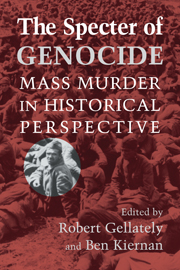Book contents
- Frontmatter
- Contents
- List of Contributors
- Acknowledgments
- INTRODUCTION
- 1 The Study of Mass Murder and Genocide
- PART I GENOCIDE AND MODERNITY
- PART II INDIGENOUS PEOPLES AND COLONIAL ISSUES
- PART III THE ERA OF THE TWO WORLD WARS
- PART IV GENOCIDE AND MASS MURDER SINCE 1945
- CONCLUSIONS
- Appendix: Convention on the Prevention and Punishment of the Crime of Genocide
- Index
1 - The Study of Mass Murder and Genocide
Published online by Cambridge University Press: 05 June 2012
- Frontmatter
- Contents
- List of Contributors
- Acknowledgments
- INTRODUCTION
- 1 The Study of Mass Murder and Genocide
- PART I GENOCIDE AND MODERNITY
- PART II INDIGENOUS PEOPLES AND COLONIAL ISSUES
- PART III THE ERA OF THE TWO WORLD WARS
- PART IV GENOCIDE AND MASS MURDER SINCE 1945
- CONCLUSIONS
- Appendix: Convention on the Prevention and Punishment of the Crime of Genocide
- Index
Summary
The twentieth century has been well described as an “age of extremes.” There were two world wars, major revolutions, colonial and anticolonial conflicts, and other catastrophes. All too often mass murder of noncombatant civilians marred these conflicts. The murders were usually state-sponsored or officially sanctioned. Indeed, by midcentury the pattern struck some scholars as so alarming that they began groping for new words to describe it. The Polish jurist Raphael Lemkin introduced the concept of genocide in a small book published during the Second World War. Later he helped prod the United Nations into formulating its Convention on the Prevention and Punishment of the Crime of Genocide in 1948. The convention defined genocide broadly as “acts committed with intent to destroy, in whole or in part, a national, ethnical, racial or religious group.” These acts included killing or causing serious bodily or mental harm to members of the group and also deliberately inflicting conditions on a people such as “to bring about its physical destruction in whole or in part.” The convention condemned measures like the prevention of births so that a people would die out and forcible transfer of a group's children to another group. Because the Genocide Convention is a good starting point for discussion of the phenomenon, we analyze both its nature and its implications.
- Type
- Chapter
- Information
- The Specter of GenocideMass Murder in Historical Perspective, pp. 3 - 26Publisher: Cambridge University PressPrint publication year: 2003
- 4
- Cited by



